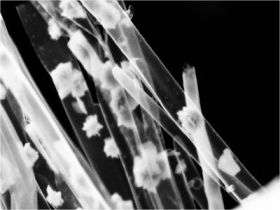New hybrid nanostructures detect nanoscale magnetism

A key challenge of nanotechnology research is investigating how different materials behave at lengths of merely one-billionth of a meter. When shrunk to such tiny sizes, many everyday materials exhibit interesting and potentially beneficial new properties.
Magnetic behavior is one such phenomenon that can change significantly depending on the size of the material. However, the sheer challenge of observing the magnetic properties of nanoscale material has impeded further study of the topic.
Researchers at Rensselaer Polytechnic Institute have developed and demonstrated a new method for detecting the magnetic behaviors of nanomaterials. They created a new process for growing a single multi-walled carbon nanotube that is embedded with cobalt nanostructures. The cobalt clusters measure from 1 nanometer to 10 nanometers.
After a series of experiments, the research team has concluded that the electrical conductance of carbon nanotubes is sensitive enough to detect and be affected by trace amounts of magnetic activity, such as those present in the embedded cobalt nanostructures. It is believed to be the first instance of demonstrating the detection of magnetic fields of such small magnets using an individual carbon nanotube.
Results of the study were reported in the paper "Detection of Nanoscale Magnetic Activity Using a Single Carbon Nanotube" recently published by Nano Letters.
"Since the cobalt clusters in our system are embedded inside the nanotube rather than on the surface, they do not cause electron scattering and thus do not seem to impact the attractive conductive properties of the host carbon nanotube," said Swastik Kar, research assistant professor in Rensselaer's Department of Physics, Applied Physics, & Astronomy, who led the project. "From a fundamental point of view, these hybrid nanostructures belong to a new class of magnetic materials."
"These novel hybrid nanostructures open up new avenues of research in fundamental and applied physics, and pave the way for increased functionality in carbon nanotube electronics utilizing the magnetic degree of freedom that could give rise to important spintronics applications," said Saroj Nayak, an associate professor in Rensselaer's Department of Department of Physics, Applied Physics, and Astronomy, who also contributed to the project.
Potential applications for such a material include new generations of nanoscale conductance sensors, along with new advances in digital storage devices, spintronics, and selective drug delivery components.
Source: Rensselaer Polytechnic Institute





















